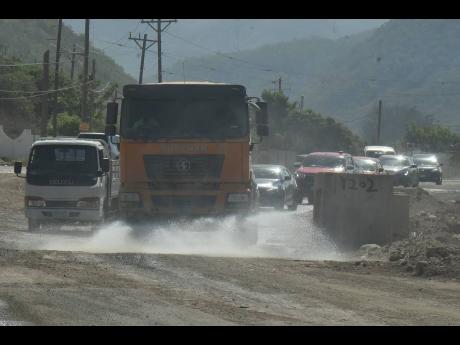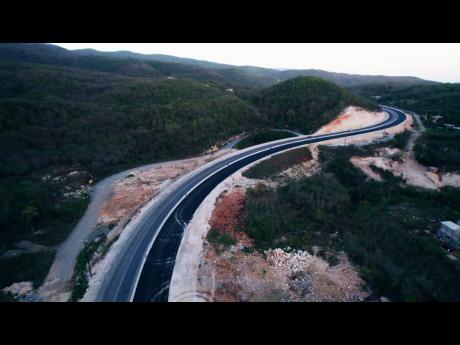‘Me eat dust and sleep inna dust’
• Health centres reporting significant spike in respiratory illnesses due to dust nuisance from South Coast Highway Improvement Project • NWA CEO asking for patience because it ‘will be worth the wait’
Geraldine Chin* began noticing in late 2021 that her then two-year-old son had developed a persistent cough. Around the same time, a multibillion-dollar road and infrastructure upgrade project spanning several parishes was making its way through...
Geraldine Chin* began noticing in late 2021 that her then two-year-old son had developed a persistent cough.
Around the same time, a multibillion-dollar road and infrastructure upgrade project spanning several parishes was making its way through her community of 8 Miles in St Andrew.
The US$367 million South Coast Highway Improvement Project (SCHIP), which began in October 2019, includes road construction as well as the installation of storm water drainage, sewage infrastructure and fibre optic cable ducts, according to the National Works Agency (NWA).
It is expected to spark an economic boom in Portland, St Thomas – long considered the forgotten parish – and some areas in eastern St Andrew.
But with health professionals reporting a significant spike in respiratory illnesses, residents along the stretch of the construction consider it both a blessing and a curse. Although anticipating what the completion of the project will bring to their communities, they are wondering if it is worth it because of the health challenges they now face caused by the dust nuisance.
Chin is one of them.
She admitted that at the time she paid very little attention to her son’s coughing, especially since he had no medical issues up to that point.
“It was coming down to December [2021] and they were saying this is the time children normally cough and stuff so I wasn’t really paying it any mind,” she told The Sunday Gleaner during an interview last Wednesday.
But since the beginning of this year, the now four-year-old boy’s health took a turn for the worse, according to his mother, who says a chronic cough and constant vomiting has left him dependent on a nebulizer pump.
The distraught mother said she has lost count of the times she had to rush her son to a doctor for emergency treatment.
“The way him get antibiotics him body immune to it. They have to now try and find another antibiotic that he’s not immune to that can work,” she noted.
Two weeks ago, doctors at the Bustamante Hospital for Children confirmed that he was asthmatic and that the respiratory illness has been exacerbated by over-exposure to the dust, she disclosed.
The asthma diagnosis left her stunned, she said, because this was never detected in any of the countless doctor visits or tests she has done before this.
“When I took him to Children’s they asked me if he is around a lot of dust. I told them that the roadwork is right in my backyard and I can’t hide from the dust. Every day I come home I have to be sweeping out dust,” Chin said.
“And they said that’s what’s affecting him.”
Asthma is a “chronic condition” that leads to inflammation or swelling of the airways, causing excess mucus and a narrowing or obstruction of air flow, explained Dr Charmaine Crooks Edwards, the sole pediatric pulmonologist in Jamaica’s public health sector.
Crooks Edwards, who is also employed to the Bustamante Hospital for Children, said people who have asthma “quite often have a genetic predisposition to have it”.
“So the dust by itself would not cause the asthma, but what it will do is make the symptoms worse or cause the patient to have frequent or persisting symptoms,” she said during an interview with The Sunday Gleaner on Thursday.
“The natural response of your body is to cough to try to clear it. If there is excess exposure, over time it can do harm, depending on what is in the dust.”
Crooks Edwards indicated, too, that anyone can potentially have a response to anything that irritates their airways, including dust or smoke.
“If it is very strong enough, it can irritate our airways. But people who have asthma may have very exaggerated responses to these irritants because of the underlying problems they have.”
A BLANKET OF DUST
When The Sunday Gleaner visited the communities close to the SCHIP roadworks last Thursday, a thick veil of dust, aided by the steady flow of traffic and a slight wind, blanketed plants, trees, parked vehicles, among other things.
As the team made its way through the air of dust, speaking to some of the residents, one woman, who shared that she and her son were asthmatic, had tarpaulins tied on her verandah grille in a desperate attempt to keep out the pollutant.
“Me eat dust and me sleep inna dust,” lamented the woman, who did not want her name published.
Minutes later and metres from her home, a truck fitted with a water sprinkler made the rounds in the Copacabana area.
Water trucks are dispatched to affected communities eight times per day, the driver told The Sunday Gleaner. But residents of some communities say the sprinkling of the water to keep down the dust is irregular.
At the Bull Bay Health Centre, medical personnel informed The Sunday Gleaner that they have seen a significant spike in the number of residents turning up with asthma, sinus, allergies and other respiratory illnesses.
The Bull Bay Health Centre is now operating from the Harbour View Health Centre, located several miles away, because of the roadwork, according to employees.
Doctors and nurses there declined to disclose numbers because they are not authorised to speak to the media, but one doctor said, “We are seeing far more cases than we would normally see at this time of the year.”
RESULTS FROM DUST MONITORING TESTS
The results of dust monitoring tests conducted in February were normal for three of the five communities impacted by the Bull Bay leg of the road project, according to a report shared with this newspaper by the NWA.
The tests are mandated by a permit the NWA obtained from the regulatory authority, the National Environment and Planning Agency (NEPA).
The communities of Rest Haven and Alma Ville Estates saw slightly elevated dust levels when compared with similar tests done in May 2019, five months before the roadworks commenced, the report indicated.
Data from dust monitoring tests conducted last month are still being analysed, chief executive officer of the NWA, EG Hunter, disclosed.
“The empirical data shows that compared to the baseline, the project is in general compliance,” Hunter told The Sunday Gleaner on Thursday, making reference to the permit issued by NEPA.
Despite the findings, he said the NWA has “noted the increase in and the impact of the fugitive dust during the dry season and has requested that the contractor increase current mitigation measures”.
The dust nuisance stems from the fact that the project is “excavation intensive”, particularly in the early stages during the installation of critical infrastructure such as water supply pipelines, drains and cable ducts, the NWA boss explained, while noting the complaints.
The Bull Bay leg of the SCHIP is a design and construct contract, the NWA disclosed. The design period commenced eleven months from the date the project started, followed soon after by the construction phase.
The Harbour View to Yallahs leg of the project, which takes in Bull Bay and adjoining areas, was scheduled to be completed early this month, but has now been pushed back by nearly three months because of several factors, including the acquisition of lands.
The NWA CEO said projects like SCHIP are “never easy”, but are important for Jamaica’s transformation and “will be worth the wait”.
He said the “dangers” facing societies, including Jamaica, is that the need for no-hassle implementation serves as a deterrent to these kinds of projects.
“For this country, or any other country for that matter, to truly be transformed, it must take on and implement some very difficult tasks, whether they be technical or social,” Hunter said.
“These tasks are never easy and generally the implementers are never popular. It is only when the tasks are completed, sometimes years after, that the value to society becomes evident.”
[*Name changed to protect identity]








